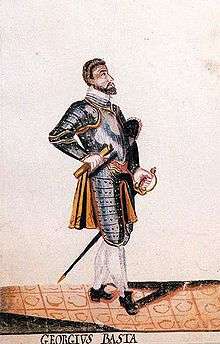Giorgio Basta
| Giorgio Basta | |
|---|---|
 | |
| Born |
1544 La Rocca, Kingdom of Naples |
| Died |
1607 (aged 62–63) |
| Allegiance |
|
| Service/branch | Imperial Army |
| Rank | General |
| Battles/wars | |
Giorgio Basta, Count of Huszt (1544 – 1607) was an Italian general employed by the Holy Roman Emperor Rudolf II to command Habsburg forces in the Long War of 1591–1606. He was later sent to administer Transylvania as an Imperial vassal[1] and to restore Catholicism as the dominant religion in the region.[2]
On his orders, his ally Michael the Brave, who unified Transylvania, Wallachia, and Moldavia, was assassinated on 9 August 1601, a few days after the common victory at the Battle of Guruslău, for trying to turn against Rudolf II. For this, he is often depicted as disloyal and violent by Romanian and Hungarian historians. Basta was also the author of books on the art of military leadership.
Biography
Basta was born to an Arbëreshë family[3][3][4][5][6][7][8][9][10] in La Rocca, modern day Roccaforzata, a village in Salento, Italy.
He began his military career in the service of Charles V and Philip II of Spain, mainly on the French front during the War of the Three Henrys and the Catholic League. In 1590 he joined the forces of Alexander Farnese, Duke of Parma in Flanders. During the siege of Rouen he was almost killed by Sir Roger Williams, who sliced his neck in personal combat.[11]
After the death of Farnese, on the recommendations of Philip II, he joined the army of Emperor Rudolf II, serving mainly in Hungary, commanding Habsburg forces during the "Long War" against the Ottoman Empire. Ambrogio Merodio in his Istoria Tarantina, calls him the "terror of Ottoman arms".
On his orders, his ally Michael the Brave, the former ruler of Transylvania, Wallachia and Moldavia, was assassinated at Keresztesmező camp,[12][13][14] near Câmpia Turzii, because Basta considered him a liability. The event happened on 9 August 1601,[15] only days after a joint victory in Battle of Guruslău.
During his brief period of control over Transylvania, Basta tried to uproot Protestantism. Following Papal imperial policy, Calvinist Hungarians and Szeklers, Orthodox Walachians and Serbs, and Lutheran Saxons were subject to any kind of abuse. Following years of warfare and his ruthless regime, famine and plague appeared in Transylvania. In 1604 Basta twice defeated forces led by Stephen Bocskay, who attempted to oppose his rule over Transylvania.[16]
After his experiences of warfare in Eastern Europe he went to Prague, where he died.
Basta wrote several military manuals, the best known of which are his Il maestro di campo generale...(Venice 1606), and his posthumous work Il governo della cavalleria leggiera (Venice 1612).[17] Both were translated into German and into French.
Gallery
-

17th century aquarell of Basta
References
- ↑ Jeremy Black (2002). European Warfare, 1494-1660. Psychology Press. pp. 199–. ISBN 978-0-415-27532-3.
- ↑ Setton, K.M. (1991). Venice, Austria, and the Turks in the Seventeenth Century. American Philosophical Society. ISBN 9780871691927.
- 1 2 Hanlon, G. (2014). The Hero of Italy: Odoardo Farnese, Duke of Parma, His Soldiers, and His Subjects in the Thirty Years' War. OUP Oxford. ISBN 9780199687244.
- ↑ Encyclopedia Britannica. Encyclopedia Britannica, inc., William Benton Publisher. 1973. ISBN 9780852291733.
- ↑ Telos. Telos Press. 1989. ISSN 0090-6514.
- ↑ Coetzee, D.; Eysturlid, L.W. (2013). Philosophers of War: The Evolution of History's Greatest Military Thinkers [2 Volumes]: The Evolution of History's Greatest Military Thinkers. ABC-CLIO. ISBN 9780313070334.
- ↑ Murray, J.; BLEWITT, O.; PENTLAND, J.B. (1868). A Handbook for Travellers in Southern Italy ... Sixth edition [of the work originally written by Octavian Blewitt], revised and corrected on the spot. [The editor's preface signed: J. B. P., i.e. Joseph B. Pentland.].
- ↑ Hanlon, G.; Hanlon, U.R.P.G. (2008). The Twilight of a Military Tradition: Italian Aristocrats and European Conflicts, 1560-1800. Taylor & Francis. ISBN 9781135361433.
- ↑ Lawrence, D.R. (2009). The Complete Soldier: Military Books and Military Culture in Early Stuart England, 1603-1645. Brill. ISBN 9789004170797.
- ↑ Metamorphosis Transylvaniae. Taylor & Francis. 2014. ISBN 9781317856641.
- ↑ Lawrence, David, The Complete Soldier: Military Books and Military Culture in Early Stuart England, 1603-1645, Brill, 2009, p.66.
- ↑ István Kakas (1556–1603): Persiai utazás (Trip to Persia)
- ↑ Erdélyi Múzeum 1894/11
- ↑ adatbank.transindex.ro
- ↑ Giurescu, p. 201–05.
- ↑ Venice, Austria, and the Turks in the seventeenth century Volume 192 of Memoirs of the American Philosophical Society Author Kenneth Meyer Setton Publisher American Philosophical Society, 1991 ISBN 0-87169-192-2, ISBN 978-0-87169-192-7 Length 502 pages link
- ↑ "Giorgio Basta - Enciclopedia României - prima enciclopedie online despre România". enciclopediaromaniei.ro. Retrieved 2014-09-22.
See also
External links
- Il mastro di campo generale (Venice, 1606) available on Google Books from Biblioteca Nazionale Centrale di Roma
- German translation: Il maestro di campo generale, das ist: außfürliche Anzeig, Bericht und Erklärung von dem Ampt eines General-Feldt-Obersten (Frankfurt, 1617) available on Google Books from Austrian National Library
- Il governo della cavalleria leggiera (Venice, 1612) available on Google Books from Complutense University of Madrid (scans in reverse order)
- German translation: Governo della cavalleria, Das ist, Bericht Von Anführung der leichten Pferde (Frankfurt, 1614) available on Google Books from Austrian National Library
